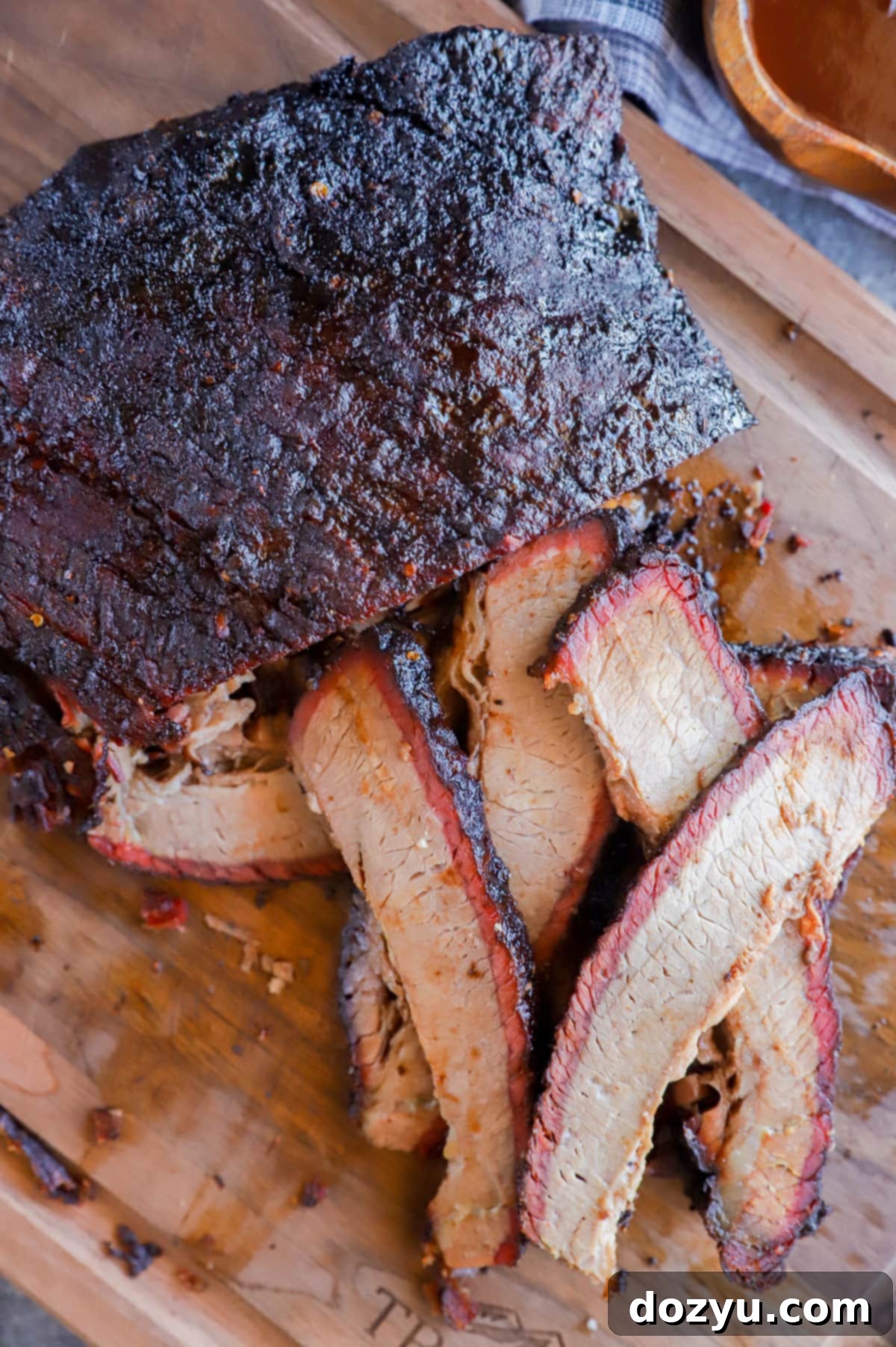The Ultimate Guide to Smoking Tender Traeger Brisket: An Easy Recipe for Beginners
Prepare to impress with this incredibly smoky, irresistibly tender, and absolutely delicious easy smoked Traeger brisket recipe. If you’re searching for a meal that truly delivers that “wow” factor, look no further – this brisket is a guaranteed crowd-pleaser and a direct route to everyone’s heart. Gone are the days of being intimidated by this magnificent cut of meat; with our comprehensive guide, even beginners can achieve pitmaster-level results!
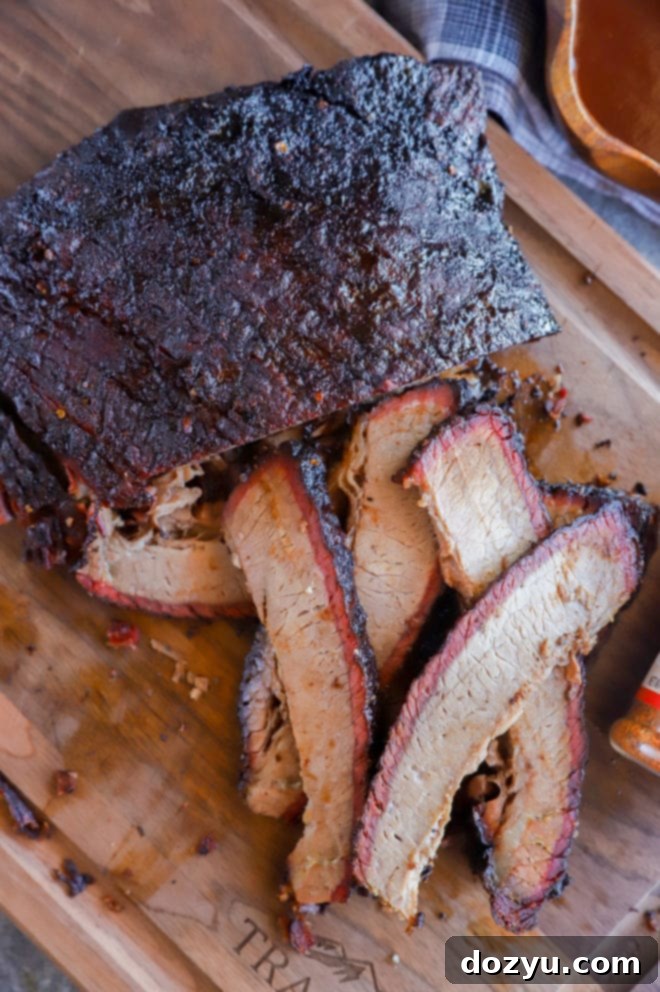
Mark your calendars! National Brisket Day, May 28th, often falls on a Saturday, creating the perfect long weekend opportunity. This is your cue to dust off your smoker and plan an unforgettable culinary adventure. Imagine: a leisurely weekend, cold beers in hand, soaking up the sunshine on your patio, all while your epic brisket slowly transforms into a masterpiece on the grill. It’s the quintessential summer experience, made even better with incredible food.
Quick Note: While this recipe specifically mentions the “Traeger” name, rest assured that the techniques and principles shared here are universally applicable. Any smoker you own will work wonderfully for achieving tender, flavorful brisket. However, I must confess my personal affection for our Traeger wood pellet grill for its ease of use and consistent results!
Table of Contents
Toggle
Why This Traeger Brisket Recipe is a Must-Try
Before we dive into the delicious details, let’s clarify a few things that make this particular Traeger brisket recipe stand out from the rest, especially if you’re looking for an approachable method to smoke brisket:
- Manageable Size: Unlike daunting 15lb briskets often seen in competitions, this recipe calls for a smaller, more practical cut. This size is ideal for feeding a gathering of 6 to 8 people, making it perfect for weekend barbecues, family dinners, or a small get-together without overwhelming your smoker or your fridge with leftovers (though leftovers are amazing!).
- Patience is Key: While this recipe is incredibly easy in terms of technique, it does require a generous amount of time and patience. Smoking brisket is a low-and-slow endeavor, allowing the meat to break down and become incredibly tender. The hours spent waiting are undeniably worth it; it’s the ultimate weekend project that allows you to relax and enjoy the process.
- Beginner-Friendly: Even if you’re not a seasoned pit master, you can absolutely master this recipe. We focus on straightforward steps and minimal ingredients, ensuring a successful and delicious outcome every time.
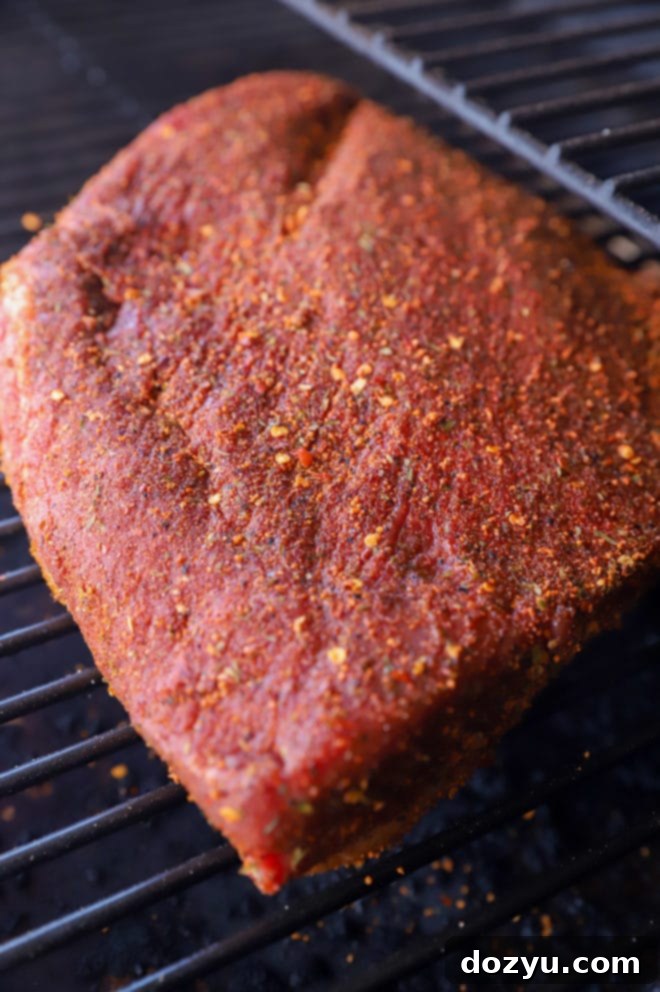
What Makes This Smoked Brisket So Special?
This recipe marks a shift from traditional indoor cooking methods for brisket, such as the oven or a slow cooker. While those techniques can certainly yield delicious results, they simply can’t replicate the depth of flavor achieved through hours of low and slow smoking on a Traeger grill. The wood pellets infuse the meat with an unparalleled smoky essence and create that desirable crispy “bark” on the exterior, something impossible to achieve indoors.
I might not call myself a professional pitmaster, but I can confidently say this is one of the easiest and most foolproof ways to make incredibly flavorful and tender brisket. It requires limited ingredients and simple techniques, making it accessible for anyone to try. This juicy, smoky brisket is guaranteed to be a sensational crowd-pleaser at your next backyard BBQ or family gathering. Get ready for rave reviews!
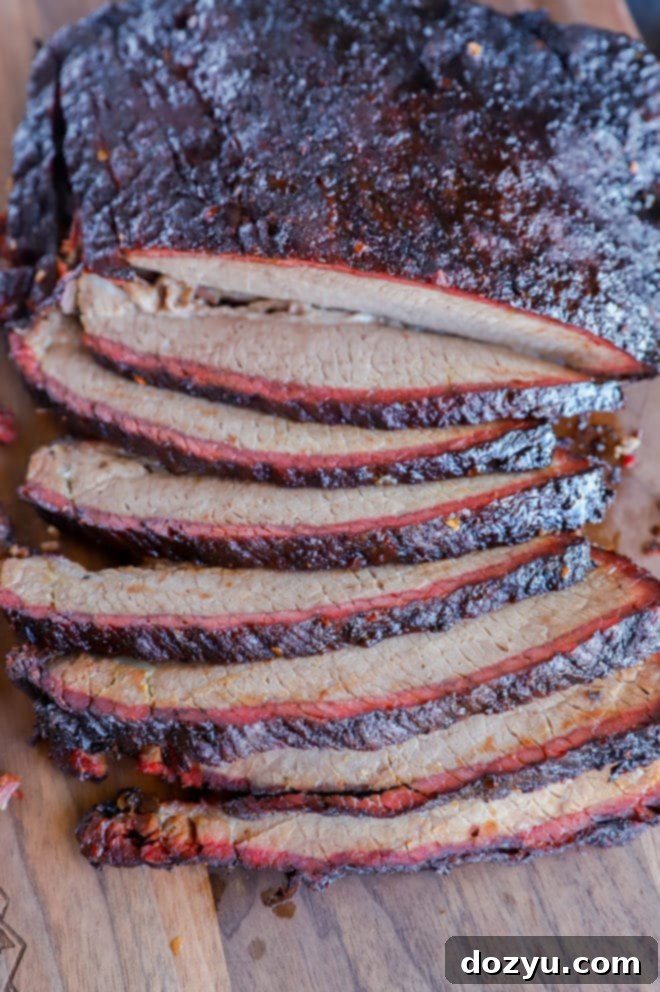
Essential Ingredients for Your Traeger Brisket
Creating an exceptional smoked brisket doesn’t require a long list of exotic ingredients. Instead, it relies on quality components that work in harmony to elevate the natural flavors of the beef. Here’s what you’ll need:
- Flat Cut Brisket: This is the leanest part of the brisket, known for its uniform thickness, which makes it ideal for slicing. It typically comes with a thick layer of fat on one side, crucial for moisture during the long smoke. Aim for a piece around 6 pounds for this recipe. For the best results, seek out a high-quality cut from a reputable local butcher; their expertise can make all the difference.
- Your Favorite BBQ Rub: The rub is paramount to building that flavorful bark. Don’t be shy here! While a simple salt and black pepper seasoning works, a good BBQ rub adds complexity. I personally adore Head Country BBQ’s Original Championship Seasoning, but feel free to use any brand or flavor profile that you love. Experiment to find your signature taste!
- Beef Broth: This forms the foundational liquid for our invaluable “mop sauce.” Store-bought beef broth is perfectly fine for convenience, but if you have homemade on hand, that will certainly add an extra layer of richness.
- Apple Cider Vinegar: A vital component of classic barbecue, apple cider vinegar introduces a delightful tang to the mop sauce. Its acidity helps to tenderize the meat slightly and balance the richness of the beef and smoke. It’s a pantry staple you’ll find yourself reaching for often.
- Worcestershire Sauce: This adds a deep, savory, umami note to the mop sauce, complementing the other flavors beautifully. If you prefer a little heat, you can substitute it with your favorite hot sauce for an added kick.
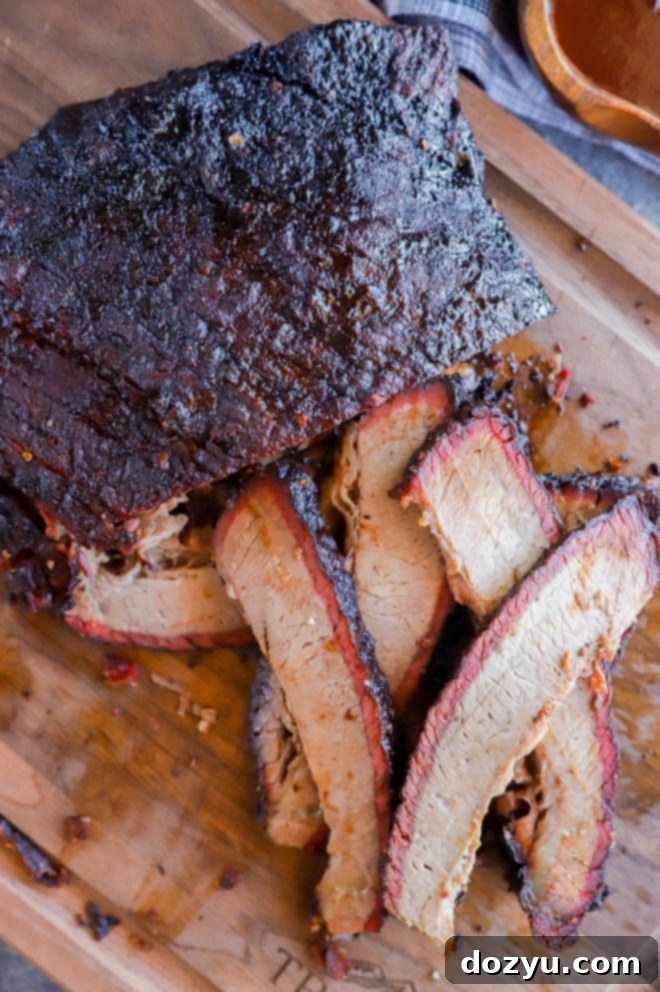
Essential Equipment for Smoking Brisket
Having the right tools can make all the difference in your brisket smoking journey. While the star of the show is undeniably your smoker, a few key accessories will ensure a smoother, more successful cook:
- Traeger Pellet Grill (or your preferred smoker): As mentioned, this recipe works with any smoker, but I highly recommend a Traeger. My own Traeger Lil Tex Elite 34 Pellet Grill has been a reliable workhorse for five years, performing as flawlessly as the day I assembled it. Pellet grills offer fantastic temperature control, which is a huge advantage for long smokes.
- Mop Brush and Basting Pot: A good mop brush is indispensable for applying your mop sauce evenly. I particularly like this cast iron basting pot and brush set, which keeps your sauce warm and ready.
- Instant-Read Meat Thermometer: This is arguably the most crucial tool. Smoking brisket is all about internal temperature, not just time. A reliable thermometer ensures your brisket is cooked to perfection without being over or underdone.
- Hickory Hardwood Grill Pellets: For Traeger users, the choice of pellets significantly impacts flavor. Hickory offers a classic, robust smoke flavor that pairs beautifully with beef brisket.
- Large Cutting Board or Baking Sheet: You’ll need a clean surface for trimming, seasoning, and resting your brisket.
- Sharp Butcher Knife: Slicing against the grain is key to tender brisket, and a sharp knife makes this task much easier and safer. A Wusthof 8″ Artisan Butcher Knife is an excellent choice.
- Tongs: For easy handling of the brisket on and off the grill.
Step-by-Step Guide: How to Smoke Brisket on a Traeger
Smoking a brisket might seem complex, but with these clear steps, you’ll find it surprisingly straightforward. Follow along to achieve that perfectly tender, smoky result.
Prepping Your Smoker & Brisket
- Preheat Your Smoker: Begin by preheating your Traeger grill (or any smoker you’re using) to a precise 180˚F (82˚C). Consistency in temperature is crucial for the initial smoke. Once it reaches the target temperature, ensure you let it preheat for at least 15 minutes with the lid closed. This allows the smoker to stabilize and develop a clean smoke.
- Season the Brisket: While the smoker preheats, take your trimmed flat cut brisket and generously season it all over with your chosen BBQ rub. Don’t be shy; a good layer of rub contributes significantly to the delicious bark. Gently press the rub into the meat to ensure it adheres well. Set the seasoned brisket aside, allowing the rub to work its magic while you prepare the mop sauce.
Crafting the Perfect Mop Sauce
- Mix the Mop Sauce: In a small bowl, combine the beef broth, apple cider vinegar, and Worcestershire sauce. Stir until all ingredients are well incorporated. This simple yet flavorful mixture will be your secret weapon for keeping the brisket moist and adding layers of flavor throughout the long smoke. Keep your mop brush ready beside the sauce.
The Smoking Process: Low and Slow for Perfection
- Initial Smoke (Low Temperature): Carefully place the seasoned brisket directly onto the preheated grill grates. Smoke at 180˚F (82˚C) for an initial 3 to 4 hours. During this phase, the brisket absorbs most of its smoky flavor. Make sure to apply your prepared mop sauce every hour with the mop brush. This not only keeps the surface moist but also helps build that desirable crust.
- The Main Cook (Higher Temperature): After the initial low-temperature smoke, increase your smoker’s temperature to 225˚F (107˚C). Continue cooking at this temperature, still applying the mop sauce approximately every hour or so. This phase will take a significant amount of time, typically another 4 to 5 hours, but could vary based on the brisket’s size and your smoker’s efficiency. The goal is to cook until an instant-read thermometer, inserted into the thickest part of the meat (avoiding any large fat pockets), reads between 190˚F and 200˚F (88˚C to 93˚C). We’re aiming for an ideal internal temperature of 195˚F (91˚C) when it comes off the smoker.
- Resting for Tenderness: Once your brisket reaches the target internal temperature, remove it from the grill and transfer it to a clean cutting board or a baking sheet. Immediately cover it tightly with aluminum foil. This resting period is critical – do not skip it! Allow the brisket to rest for at least 30 minutes, but a full hour is even better. This allows the juices to redistribute throughout the meat, resulting in an incredibly tender and moist final product.
- Slice and Serve: Once rested, unwrap the brisket. Using a sharp butcher knife, slice the brisket against the grain into pencil-thick slices. Serve immediately with your favorite BBQ sauce on the side and prepare for an explosion of flavor!
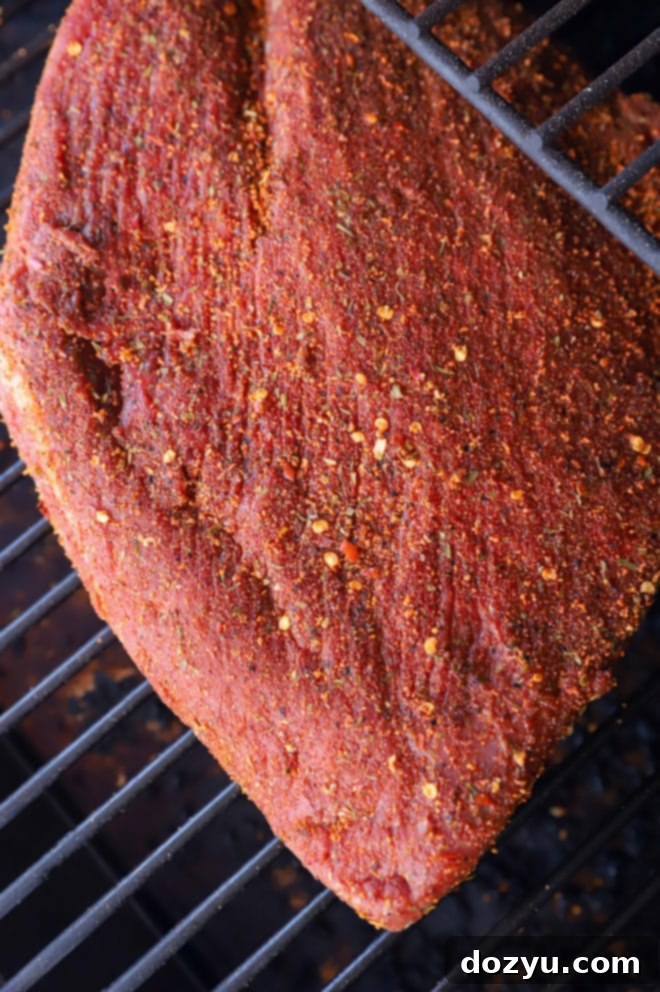
Expert Tips for a Perfect Smoked Brisket
Achieving a truly exceptional smoked brisket is about more than just following steps; it’s about understanding the nuances of the cooking process. These expert tips will help you elevate your brisket from good to unforgettable:
- The Golden Rule of Resting: This cannot be overstated – resting your brisket is paramount for tenderness and juiciness. After removing the brisket from the smoker, transfer it to a cutting board or baking sheet, cover it loosely with foil, and let it rest for a minimum of 30 minutes. An hour is even better! During this time, the internal temperature will continue to rise slightly (carryover cooking), and the muscle fibers will relax, allowing the juices to redistribute evenly throughout the meat instead of gushing out when sliced. Skipping this step will result in a drier, tougher brisket.
- Maximizing Leftovers: A 6lb brisket often means delicious leftovers, and they are just as versatile as the fresh cut! Don’t let a single slice go to waste. Consider transforming leftover brisket into a hearty BBQ charcuterie board, piling it high on sandwiches (like a classic Reuben with a smoky twist), or incorporating it into tacos, quesadillas, or chili. The possibilities are endless, and smoked brisket adds incredible depth to almost any dish.
- Slicing Against the Grain for Tenderness: This is a critical step often overlooked. Brisket has a distinct grain (the direction of the muscle fibers). To ensure maximum tenderness with every bite, you must slice against the grain. If you slice with the grain, the meat will be chewy and stringy. Take a moment to identify the grain before you start slicing. This simple technique breaks down those long fibers, making the meat incredibly soft and easy to eat.
Craving more classic BBQ recipes? Explore these favorites: Honey BBQ Grilled Chicken Wings | BBQ Apple Cider Ribs | Gourmet BBQ Burger Bar | Grilled Chipotle BBQ Chicken Skewers
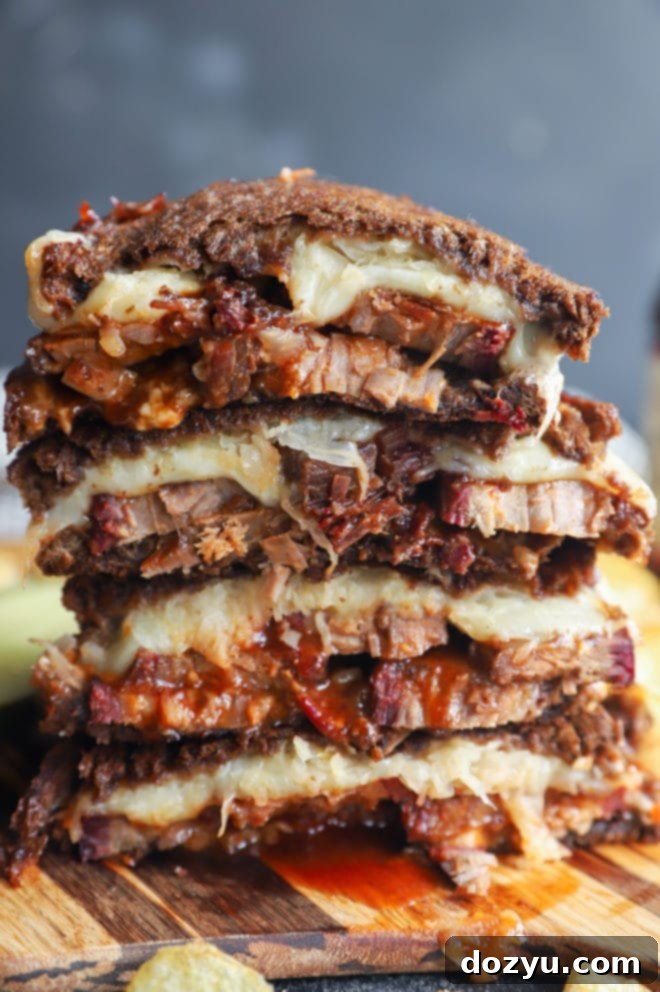
Frequently Asked Questions About Smoking Brisket
Smoking brisket often comes with a host of questions, especially for those new to the craft. Here are answers to some of the most common queries to help you on your way to brisket mastery:
What is a Mop Sauce and Why Use It?
A mop sauce, sometimes called a basting liquid, is typically a thin, vinegar-based liquid applied to meat during the smoking process. Its primary purpose is to keep the surface of the meat moist, preventing it from drying out over the long cooking period. Beyond moisture, it adds layers of flavor, helps create that desirable crunchy “bark” on the exterior, and assists in locking in the meat’s natural juices. Our recipe features a simple, three-ingredient mop sauce made from staple pantry items, proving you don’t need complexity for incredible results.
To Wrap or Not to Wrap Your Traeger Beef Brisket?
The decision to wrap brisket, often in butcher’s paper or foil, is a common debate among pitmasters. In this specific recipe, because we are consistently applying a mop sauce, there’s no need to wrap the brisket during the smoking process. The mop sauce serves the same purpose of preventing the exterior from drying out and helps manage the “stall” (where the internal temperature plateaus). However, if you prefer not to use a mop sauce, wrapping the brisket in butcher’s paper once it hits around 160-170˚F (71-77˚C) internal temperature is a common technique to push through the stall and retain moisture. It’s a matter of preference and technique.
Fat Side Up or Down: The Great Brisket Debate
Ah, the age-old question that sparks lively discussions in the barbecue world! Some argue fat side up allows the fat to render and baste the meat below, while others insist fat side down protects the leaner flat from the direct heat of the smoker. Honestly, I haven’t found a significant difference in the final product between the two methods when smoking on a Traeger or similar pellet grill that cooks with indirect heat (please, no angry pitmasters!). For the brisket pictured in this guide, I opted for fat side down. Feel free to experiment and see what works best for your smoker and your preferences.
Decoding the Smoke Ring
That beautiful pink ring around the edge of your smoked meat? That’s the coveted smoke ring! It’s a visual hallmark of expertly smoked barbecue, appearing between the crusty bark and the interior brown-colored meat. While it doesn’t impart any distinct flavor, it’s a testament to proper smoking technique and looks absolutely stunning. The smoke ring forms when nitric oxide and carbon monoxide from the wood smoke react with myoglobin in the meat. To achieve it, you need to cook your brisket low and slow, allowing these chemical reactions to occur before the myoglobin breaks down from high heat.
Achieving the Ideal Brisket Internal Temperature
Temperature is king when smoking brisket. A properly smoked brisket is generally considered done when it reaches an internal temperature of 195˚F (91˚C). The minimum safe consumption temperature for cooked beef is much lower, but for tender brisket, you need to cook it longer to break down connective tissues. Many pitmasters aim for a range between 202˚F and 205˚F (94˚C to 96˚C) for optimal tenderness. In my experience, removing the brisket from the smoker at 195˚F allows for a perfect carryover cook during the resting period, bringing it into that ideal range. Crucially, do not let the internal temperature exceed 210˚F (99˚C), as this will likely result in a dry, overcooked brisket.
Can I Use This Recipe with a Charcoal or Stick Burner Smoker?
Absolutely! This recipe is adaptable to charcoal or stick burner smokers. The key difference will be temperature management. Pellet grills like the Traeger offer precise temperature control, making the process somewhat hands-off. With a traditional charcoal or stick burner smoker, you’ll need to be more vigilant in monitoring and adjusting the heat. This might involve more frequent tending to the fire, vents, and fuel. Be prepared for potentially longer cooking times as maintaining consistent heat can be more challenging. Always prioritize monitoring the internal temperature of the meat with a reliable thermometer.
Should I Brine My Brisket?
While I didn’t brine my brisket for this recipe, it’s certainly an option you can explore. Brining can add moisture and flavor, especially if you’re concerned about dryness. However, with a good mop sauce and careful temperature management, you can achieve a wonderfully moist brisket without brining. It really comes down to personal preference and the specific flavor profile you’re aiming for. If you do choose to brine, ensure it complements your chosen BBQ rub and mop sauce ingredients.
Need some more inspiration for meaty mains? Check out my meat main recipes page!
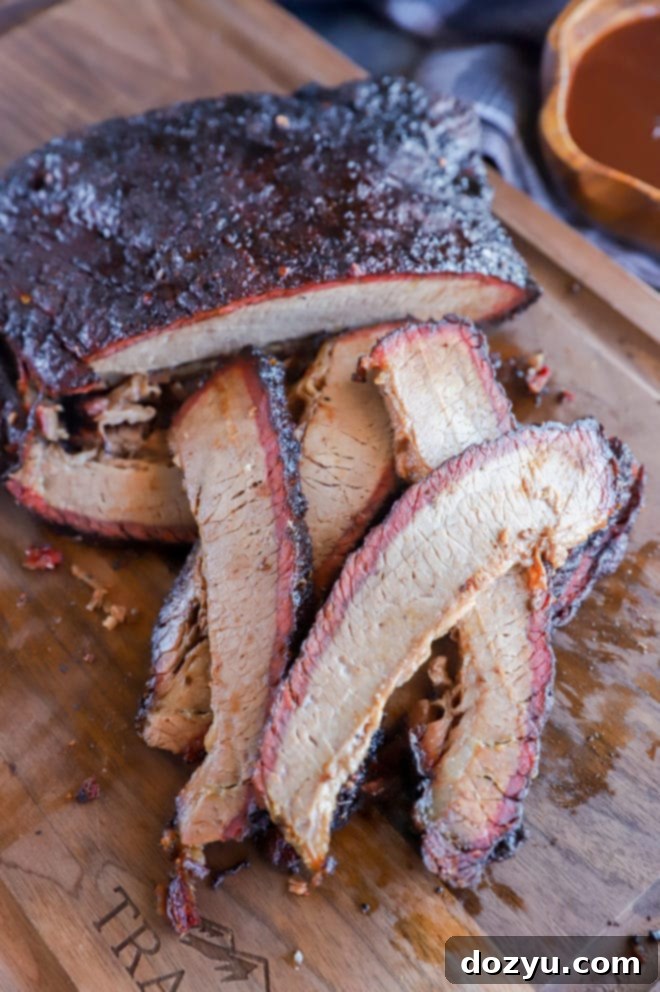
Serving Suggestions: What Pairs Best with Smoked Brisket?
Since this incredible smoked brisket is designed to feed a happy crowd, let’s assemble the ultimate menu to complement this gorgeous slab of meat. These pairings will turn your meal into a full-fledged barbecue feast!
- Appetizers to Kick Things Off: Start your meal with something truly enticing. A warm, gooey, and cheesy spinach artichoke goat cheese dip is always a hit. For a lighter, more summery option perfect for barbecues, this vibrant tomato peach bruschetta is a breeze to whip up and offers a refreshing start.
- Delicious Sides to Complete the Meal: When it comes to sides, I love modern twists on classic barbecue accompaniments. For a hearty and flavorful potato dish, these loaded bacon potato skewers are incredibly satisfying. A bright and zesty summer lemon pasta salad offers a wonderful contrast to the rich brisket. If you crave a crunchy potato side, our oven fried potatoes and onions are surprisingly easy to make and boast an unbeatable crispness. And don’t miss out on fresh summer corn transformed into this unique and flavorful masala corn salad – it’s a must-try!
- Refreshing Drinks to Quench Your Thirst: Wash down all that deliciousness with a big batch of refreshing beverages. A pitcher of vodka strawberry lemonade or tangy limeade margaritas will keep everyone cool and happy.
If you’re a fan of all things Traeger, be sure to explore more recipes! Check out these amazing Traeger chicken wings recipes for another smoky delight, or try this tender smoked pork loin for a different kind of succulent main.
Storage and Reheating Your Brisket
Proper storage ensures your leftover brisket stays delicious, and knowing how to reheat it correctly prevents it from drying out.
- Storing Leftovers: Once cooled, transfer any leftover brisket to an airtight container. It will keep beautifully in the refrigerator for up to 4 days.
- Reheating for Best Results: To reheat, wrap individual portions of sliced brisket tightly in aluminum foil. Place the foil-wrapped brisket in a baking dish or on a rimmed baking sheet. Warm in a preheated 300˚F (150˚C) oven for approximately 15 to 20 minutes, or until it’s warmed through to your liking. Reheating gently helps retain moisture.
- Freezing for Longer Storage: If you have a substantial amount of leftovers, freezing is an excellent option. Place the sliced brisket in a resealable freezer bag, pressing out as much air as possible to prevent freezer burn. It can be frozen for up to 3 months.
- Thawing Frozen Brisket: To thaw frozen brisket, simply transfer the bag to a plate and let it defrost in the refrigerator overnight. Once thawed, reheat as instructed above.
Finally, if you embark on this incredible journey to make this easy smoked Traeger brisket recipe, please be sure to give this recipe a rating and/or leave a comment below! I absolutely love hearing about your culinary successes and genuinely take the time to respond to every single comment. Your feedback is invaluable!
Feel free to drop any questions you might have in the comments section – I’m here to help you achieve brisket perfection!
Oh, and don’t forget to tag me on Instagram if you make the recipe! Seeing these delicious creations come to life in your homes truly means the world to me – it’s my favorite thing to browse through your photos and share in your cooking triumphs!
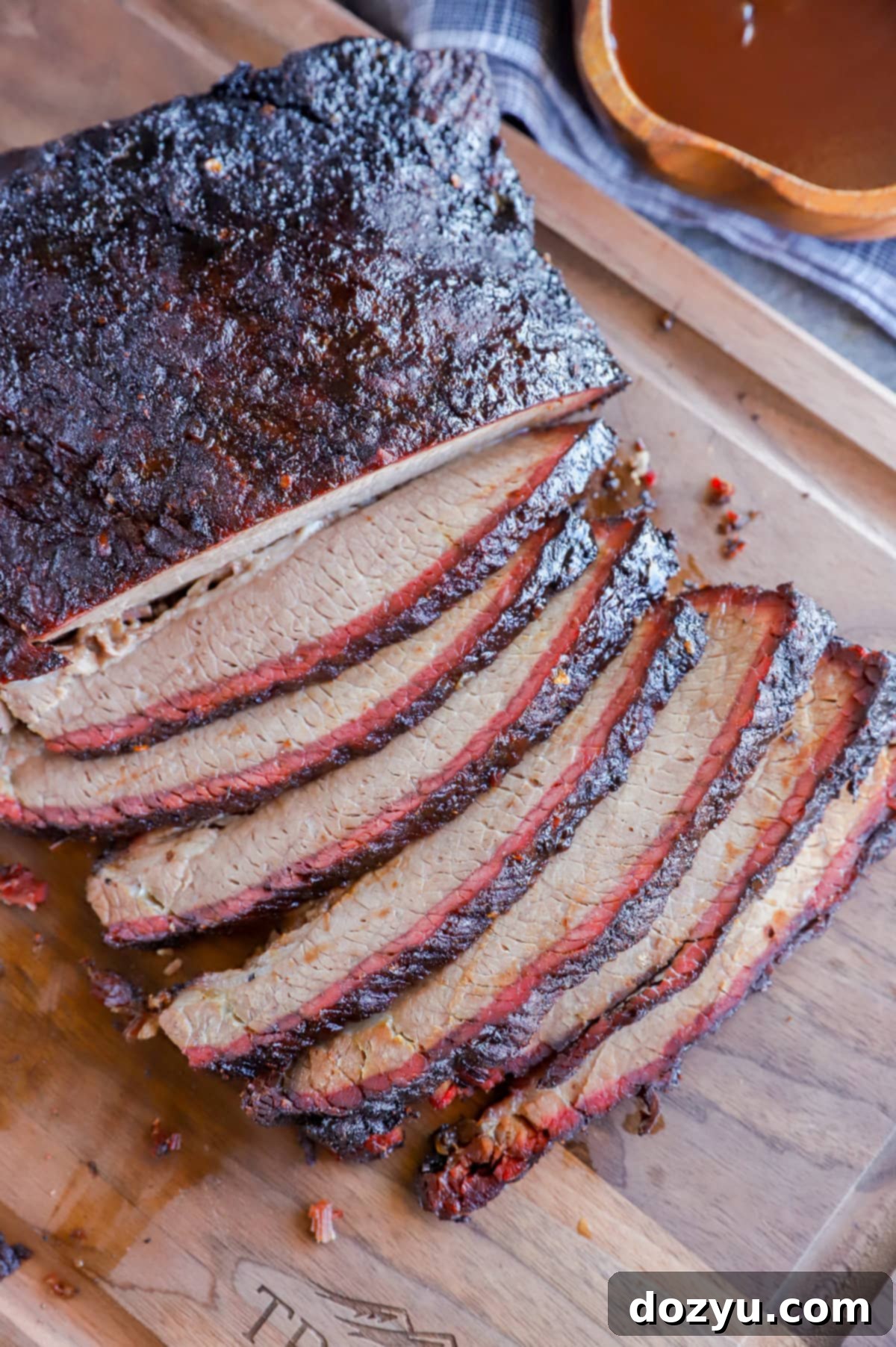
Easy Smoked Traeger Brisket
Equipment
-
Cast Iron Basting Pot and Brush
-
Traeger Lil Tex Elite 34 Pellet Grill
-
Hickory Hardwood Grill Pellets
-
9-Inch Tongs
-
Utility Cutting Board
-
Wusthof 8″ Artisan Butcher Knife, Hollow Edge
Ingredients
- 1 6 lb flat cut brisket, trimmed
- 1/4 cup your favorite BBQ rub I like to use Head Country Championship or High Plains Heat Seasoning
- 2 cups beef broth
- 1/3 cup apple cider vinegar
- 1 Tbsp Worcestershire sauce
- Serving: your favorite BBQ sauce
Instructions
-
Preheat Traeger grill (or smoker of your preference) to 180˚F (82˚C). Once preheated, make sure to let it sit, lid closed, for 15 minutes before adding the meat to stabilize the temperature.
-
Season the brisket generously all over with your chosen BBQ rub, pressing it gently to adhere.
-
In a small bowl, stir together the beef broth, apple cider vinegar, and Worcestershire sauce to create the mop sauce. Set aside.
-
Place the seasoned brisket on the grill grates and smoke for 3 hours at 180˚F (82˚C), applying mop sauce with a mop brush every hour.
-
Increase the smoker temperature to 225˚F (107˚C) and continue cooking, applying mop sauce every hour or so. Continue cooking until an instant-read meat thermometer reads 195˚F (91˚C) when inserted into the thickest part of the meat (avoiding fat). This will take approximately 4-5 additional hours.
-
Once the target temperature is reached, remove the brisket from the grill, transfer it to a cutting board or baking sheet, and wrap it tightly in aluminum foil.
-
Let the brisket rest for at least 30 minutes to 1 hour. This crucial step allows the juices to redistribute, ensuring maximum tenderness and moisture.
-
When ready to serve, unwrap the brisket, slice it against the grain with a sharp knife, and serve with your favorite BBQ sauce.
Notes
